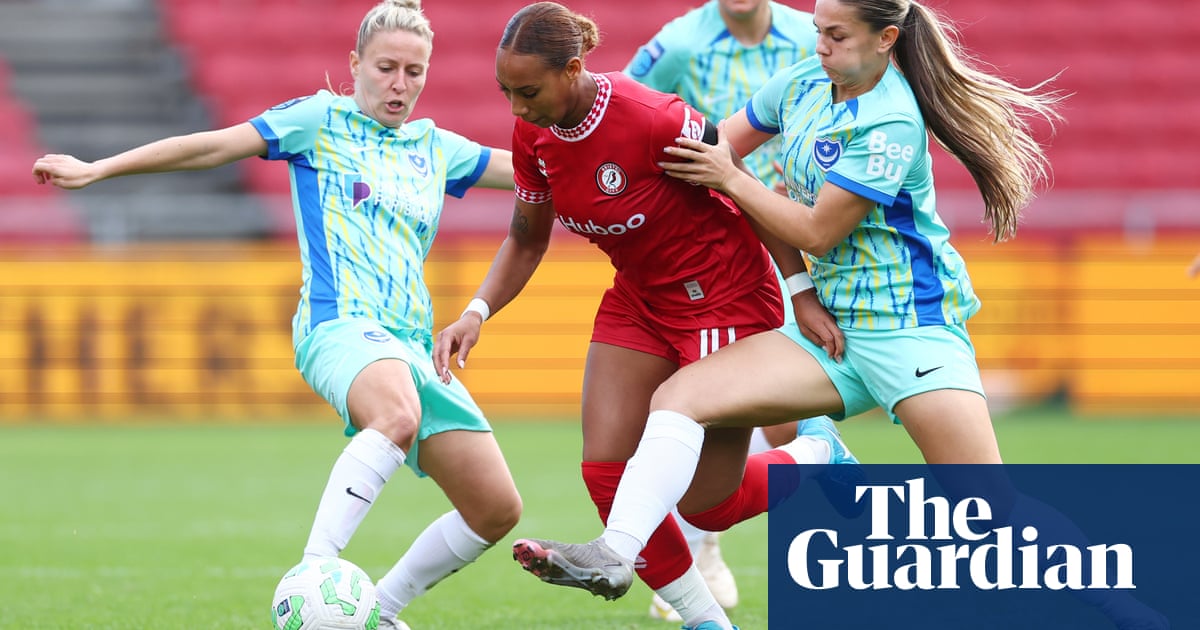Bristol City have outlined a plan to become “the destination of choice” for England’s most talented young women’s players’ and drive revenue through player sales, in a new and unique-looking women’s club strategy for the next three years.
The Women’s Championship club, founding members of the Women’s Super League in 2011 under their previous name, Bristol Academy, say they want to inspire their community by providing a pathway to play for England. They believe that recent rises in transfer fees in the global women’s game will make their philosophy of developing youngsters and selling them on a feasible model for the first time in women’s football.
With a series of goals outlining what they want to achieve by 2027, the club’s new strategy is notable for its absence of on-pitch targets such as specific silverware, nor any pledge to climb up to a certain position in the pyramid. Instead, their numerous objectives include having a player in every England youth international age group, to double their sponsorship revenue, and grow attendances by ensuring their squad collectively fulfil over 100 community engagements a season, with the aim of long-term growth.
The Bristol Sport group chief and women’s team’s chairman, Gavin Marshall, told the Guardian their summer sale of the England youth international defender Naomi Layzell to Manchester City represented a significant shift in the viability of the development of youngsters being sustainable financially.
“We haven’t been rewarded for that, historically. We’ve had a number of players go for no fee,” Marshall said. “But Naomi Layzell was a fantastic story for everyone. She went for a six-figure fee to Man City. We’re immensely proud of the journey Naomi has been on, but it’s the first time where we can sit back and be totally pleased that we’ve been treated fairly by the system. We have been compensated for our development of Naomi.
“Internally it’s ‘let’s find the next Naomi’. I wouldn’t have thought 12 months ago that we’d be able to sell a player for a six-figure sum. We see the market changing, with some of the fees that are being paid, and we can see now a pathway for sustainability where we produce these players and we’re going to start being rewarded for developing them.”
Naomi Layzell scores to put Manchester City en route to a famous win against the Women’s Champions League holders, Barcelona. Photograph: Steven Flynn/Action Plus/ShutterstockThat is why Bristol City – who reached the Women’s FA Cup final in 2011 and 2013 as Bristol Academy – state in their strategy document that ‘player trading will be a new revenue-driving focus for the club’, but additionally they also feel they have a duty to their local area to develop homegrown, future Lionesses. The club’s first head of women’s football, Romaney Pinnock, who was previously the head of women’s football at the South African FA, was appointed in August and says: “Bristol City has the opportunity to actively shape the futures for so many young people through our women’s teams. We can change the narrative around what girls can aspire to, what girls can become, what female leadership can look like and what strong female bodies look like. This is critical not just for girls and women in our communities, but for boys and men too.”
The club’s plans also include eye-catching ambitions regarding attendances at Ashton Gate, the ground they share with their men’s team and Bristol Bears rugby club. Last term in the WSL, before being relegated, Bristol City Women’s attendances rose to an average of 6,987, the fifth-highest in the WSL, with 1,800 season tickets sold, 64% of which were bought by women or girls. Those crowds have decreased significantly with the team in the Championship but the club’s aim is to ensure a 10% increase in season ticket sales year-on-year, and attract “2,000 new fans each year for the women’s games at Ashton Gate”, including 1,000 new fans under 12.
To achieve that, they intend for all their players to make a minimum of six community appearances a year, and Pinnock – who believes they also have a lot of crossover with potential fans for Bristol Bears women’s rugby team – said: “The fans of the women’s game are quite different, we’re learning that across the world. By working closely with the community, we can tap into a younger generation through our work in schools and introduce them to the women’s game.
“A lot of potential fans who have not been fans of football at all, or sport, are still in that catchment of the type of people starting to take an interest in women’s sport. We’re quite confident they’re going to have a wonderful time, so once you have that first hook in, you can create a fan for life.”
skip past newsletter promotionSign up to Moving the Goalposts
No topic is too small or too big for us to cover as we deliver a twice-weekly roundup of the wonderful world of women’s football
after newsletter promotion
The club says they will “commit to delivering more player appearances than any other professional women’s football team in the UK” and employ women’s football experts across their organisation. Marshall describes their values as “maverick and progressive”. On the pitch, they are sixth in the Championship but have won three consecutive league fixtures under the new head coach, Steve Kirby. By 2027, the measures of their off-pitch success ought to be a fascinating case study that is relevant to the sustainability of the women’s game.
This article was amended on 23 October 2024 to clarify that it was Bristol Academy that were founding members of the Women’s Super League and reached the Women’s FA Cup final in 2011 and 2013.
∎
